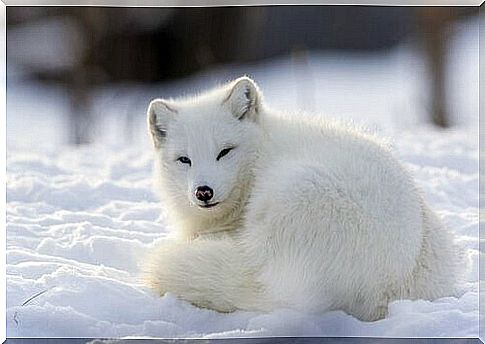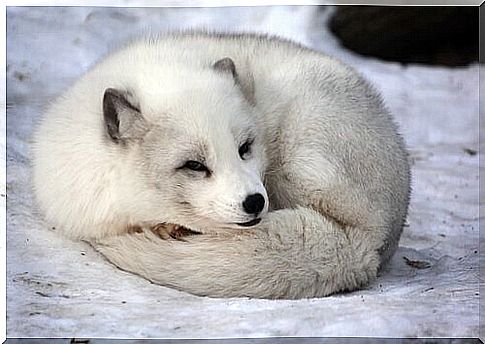The Arctic Fox: A Social And Territorial Animal

Also known as the ice fox, it is a small mammal in the canine family that inhabits the northernmost point of our planet. In this article, you will learn all there is to know about the arctic fox.
Arctic fox: distribution and habitat
The arctic fox has its habitat on the tundra, in northern America, Europe and Asia. It is usually found in Greenland, Iceland, Alaska, Canada, and the Bering Sea.
It prefers ice areas and has been sighted near the North Pole, for example, but is also native to boreal forests up to 3000 meters above sea level.
Physical characteristics of the arctic fox
One of the most important physical characteristics of the arctic fox is its white fur, which can vary in color depending on the season, becoming grayer or brownish in summer. When the temperatures rise, the fur is shorter.
In winter , his thick layer of hair enables him to withstand the very low temperatures (even -50 ° C) and to camouflage himself in the white landscape. The balls of his feet are also covered with protective fur.

Its large tail allows it to curl up on it to sleep, which prevents its body temperature from dropping. To keep the warmth even better, it has small ears, which is why its hearing may be less developed than that of dogs or other foxes.
However, it can also detect the movement of the prey several centimeters under the snow.
Arctic fox: reproduction and behavior
The month of mating is March because then there are more rodents or seabirds – depending on where it is – to eat. The females give birth to an average of 14 puppies in May.
In the following period, during the summer, both the male and the female take care of the rearing and care of the puppies.
The mortality rate of the puppies is very high due to the climatic conditions. They have to “stick” very closely to the mother to get enough warmth, and they are also very susceptible to attack by larger animals.

While the puppies are being raised, the whole family lives in elevated caves formed by a complex network of tunnels. These can be up to a square kilometer and have several entrances facing the sun.
The main prey of the arctic fox is lemmings, but it also feeds on small birds and mammals, eggs, and even seal pups. It can also eat carcasses left behind by polar bears. And if he can’t find meat, he’ll eat algae and berries.
The arctic fox remains active all year round. It does not overwinter and does not migrate to other regions. He also crosses blocks of ice in search of food if necessary. The natural enemies are the snowy owl and the wolf.
Arctic foxes are very social and do not spend time or energy isolating themselves with their partners or moving on like other dog species do. In addition, they have the peculiarity that they easily get used to the presence of people.
In addition, they are not shy at all, which has made their hunt possible for years.
Although the number of the population has declined sharply , the beautiful fur is still used for coats. But on the protection list of the IUCN (International Union for the Conservation of Nature) the arctic fox is classified as not endangered.









